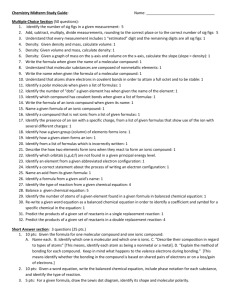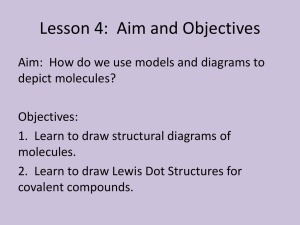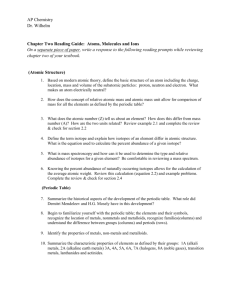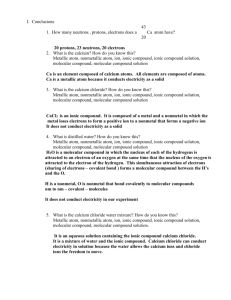SNC2P1 Chemistry Test #1 Review
advertisement
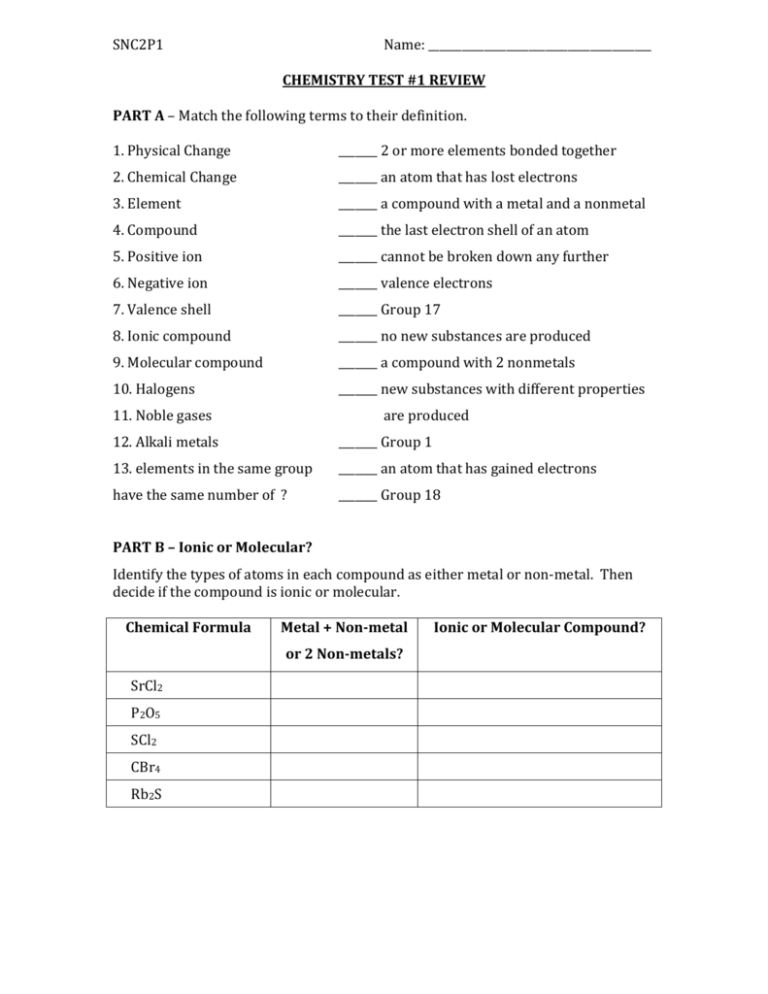
SNC2P1 Name: ________________________________________ CHEMISTRY TEST #1 REVIEW PART A – Match the following terms to their definition. 1. Physical Change _______ 2 or more elements bonded together 2. Chemical Change _______ an atom that has lost electrons 3. Element _______ a compound with a metal and a nonmetal 4. Compound _______ the last electron shell of an atom 5. Positive ion _______ cannot be broken down any further 6. Negative ion _______ valence electrons 7. Valence shell _______ Group 17 8. Ionic compound _______ no new substances are produced 9. Molecular compound _______ a compound with 2 nonmetals 10. Halogens _______ new substances with different properties 11. Noble gases are produced 12. Alkali metals _______ Group 1 13. elements in the same group _______ an atom that has gained electrons have the same number of ? _______ Group 18 PART B – Ionic or Molecular? Identify the types of atoms in each compound as either metal or non-metal. Then decide if the compound is ionic or molecular. Chemical Formula Metal + Non-metal or 2 Non-metals? SrCl2 P2O5 SCl2 CBr4 Rb2S Ionic or Molecular Compound? PART C – Use the WORD BANK below to fill in the blanks. 1. A _________________________ tells you how many atoms of the element are in the compound. 2. Metals are on the ____________________________ side of the staircase on the periodic table. 3. The protons and ____________________________ are in the ___________________________. 4. The _____________________________ are surrounding the nucleus in shells or orbits. 5. Metals will _______________________________ electrons to become stable and nonmetals will ___________________________ electrons to become stable. 6. Nonmetals will have a ________________________________ charge when they become ions and metals will have a ______________________________ charge. 7. To become stable, all atoms want a ______________________________ outer shell. 8. A group of element symbols and subscripts that represent the MAKEUP of a chemical compound is called a _______________________________. chemical formula negative gain Word Bank full left lose positive subscript nucleus electrons neutrons right PART D – Circle the best answer for each. 1. Which of the following is an element? a) water b) salt c) mercury d) pizza 2. Which is a chemical change? a) Ripping a piece of paper in two. b) Baking chocolate cupcakes. c) Dissolving sugar into coffee. d) A popsicle melting on a hot day. 3. Which of the following is a compound? a) aluminum b) carbon dioxide c) copper d) Kool-Aid in water 4. Which element has 34 electrons, 34 protons and 45 neutrons? a) rhodium b) bromine c) sodium d) selenium 5. How many valence electrons does nitrogen have? a) 2 b) 3 c) 4 d) 5 6. Which ion will calcium form to become stable? a) +2 b) +4 c) -2 d) -4 7. Which family does Chlorine belong to? a) alkali metal b) alkaline earth metal c) halogen d) noble gas 8. How many protons, neutrons and electrons does carbon have? a) 6, 7, 6 b) 8, 7, 8 c) 8, 6, 8 d) 6, 6, 6 PART E- Indicate if the following compounds are Ionic or Molecular, by putting a checkmark in the correct column. Compound sodium chloride carbon tetrachloride silver nitride magnesium oxide nitrogen monoxide Ionic Molecular PART F – Naming Compounds (Only molecular compounds have the prefixes mono, di, tri, etc.) 1. Mg3N2 __________________________________ 5. CO _________________________________ 2. LiCl _____________________________________ 6. N2O2 _______________________________ 3. BaO _____________________________________ 7. CCl4 ________________________________ 4. Al2S3 ____________________________________ 8. NH3 ________________________________ PART G – Write the formula for the following compounds. -crossover the charges (not the sign) and reduce the numbers for ionic compounds -write the number that matches the prefix for molecular compounds. 1. lithium oxide _____________________ 5. sodium chloride __________________________ 2. carbon dioxide ___________________ 6. carbon tetrafluoride _____________________ 3. potassium bromide ______________ 7. diphosphorus trisulfide __________________ 4. silicon tetraiodide _______________ 8. barium iodide ____________________________ PART H – More Formula Writing Identify the following compounds as ionic or molecular. Then write their formula. Compound Name Ionic or Molecular Compound Formula carbon monoxide zinc oxide potassium fluoride dinitrogen pentoxide aluminum sulfide phosphorus trichloride disulfur dinitride magnesium phosphide lithium iodide diphosphorus hexoxide PART I – Reading Chemical Formulas Name of Compound sodium fluoride Chemical Formula NaF calcium nitride Ca3N2 diphosphorus trioxide P2O3 boron triiodide BI3 beryllium chloride BeCl2 Number of Atoms of Each Element 1 atom of sodium 1 atom of fluorine



